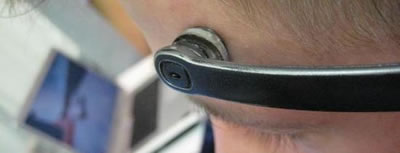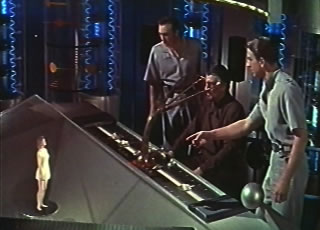Science Fiction
Dictionary
A B C D E F G H I J K L M N O P Q R S T U V W X Y Z
NeuroSky ThinkGear Mind-Controlled Toys With Sega

Silicon Valley start-up NeuroSky has been adding its ThinkGear technology to Sega Toys. The result: consumers will be able to "intimately interact with or control a toy using their mind.
The device measures brain activity as well as muscle movements; the key is the way that NeuroSky algorithms interpret the data. Users are given particular objects to focus on, and then particular mental states to achieve.

(ThinkGear in situ)
According to a recent press release:
"SEGA TOYS is taking play to the next level, and we at NeuroSky are proud to be a part of this break-through in next generation entertainment", said NeuroSky CEO Stanley Yang. “With our ThinkGear ™ bio-sensor technology and innovative capacity of SEGA TOYS, our collaboration with SEGA TOYS will empower consumers to intimately interact with or control a toy, using their mind.”We are enthusiastic about the potential we see in developing a unique franchised product line featuring NeuroSky's technology. At SEGA TOYS, our priority is to provide customers with value based on new types of play, and NeuroSky provides us with the core technology to meet this challenge.
The following video has additional details about NeuroSky and their ThinkGear tech:
(Details about NeuroSky's ThinkGear video)
Science fiction fans have been waiting for reliable mind-control interfaces and games since seeing how easy it was for Walter Pigeon to turn Krell mind control science to his own purposes in Forbidden Planet.

(From Forbidden Planet 1956)
Read more in the press release for Sega, NeuroSky and ThinkGear at the NeuroSky website; via Sega and NeuroSky to make mind-controlled toys.
Scroll down for more stories in the same category. (Story submitted 12/13/2007)
Follow this kind of news @Technovelgy.| Email | RSS | Blog It | Stumble | del.icio.us | Digg | Reddit |
Would
you like to contribute a story tip?
It's easy:
Get the URL of the story, and the related sf author, and add
it here.
Comment/Join discussion ( 3 )
Related News Stories - (" Engineering ")
Tornyol Microdrone Kills Mosquitoes
'The real border was defended by... a swarm of quasi-independent aerostats.'
PLATO Spacecraft, Hunter Of Habitable Planets, Now Ready
'I ... set my automatic astronomical instruments to searching for a habitable planet.' Edmond Hamilton (1936).
Did The Yautja Have These First?
What a marvel of ingenuity the little device was! - Harry Bates, 1934.
Jetson ONE Air Races Begin, Can Air Polo Be Far Behind?
'If you're one of those rarities who haven't attended a rocket-polo "carnage", let me tell you it's a colorful affair.' - John Victor Peterson, 1938.
Technovelgy (that's tech-novel-gee!) is devoted to the creative science inventions and ideas of sf authors. Look for the Invention Category that interests you, the Glossary, the Invention Timeline, or see what's New.
Science Fiction
Timeline
1600-1899
1900-1939
1940's 1950's
1960's 1970's
1980's 1990's
2000's 2010's
Current News
Natural Gait With Prosthetic Connected To Nervous System
'The leg was to function, in a way, as a servo-mechanism operated by Larry’s brain...'
Woman Marries Computer, Vonnegut's Dream Comes True
'Men are made of protoplasm... Lasts forever.'
Spidery 'Walk Me' Toyota Autonomous Wheel Chair Like Star Wars
Walk along with the emperor.
Dancing Robots Taught Dance Moves
'A clockwork figure would be the thing for you...'
Proof Of Robothood - Not A Person
'Who are you people? - Show 'em.'
Indonesian Clans Battle
'The observation vehicle was of that peculiar variety used in conveying a large number of people across rough terrain.'
The 'Last Mile' In China Crowded With Delivery Robots
Yes, it's a delivery robot. On wheels.
Tornyol Microdrone Kills Mosquitoes
'The real border was defended by... a swarm of quasi-independent aerostats.'
PLATO Spacecraft, Hunter Of Habitable Planets, Now Ready
'I ... set my automatic astronomical instruments to searching for a habitable planet.'
Factory Humanoid Robots Built By Humanoid Robots
'...haven't you a section of the factory where only robot labor is employed?'
iPhone Air Fulfils Jobs' Promise From 2007 - A Giant Screen!
'... oblongs were all over the floor and surfaces.'
ChatGPT Now Participates in Group Chats
'...the city was their laboratory in human psychology.'
iPhone Pocket All Sold Out!
'A long, strong, slender net...'
Did The Yautja Have These First?
What a marvel of ingenuity the little device was!
Jetson ONE Air Races Begin, Can Air Polo Be Far Behind?
'If you're one of those rarities who haven't attended a rocket-polo "carnage", let me tell you it's a colorful affair.'
Will Space Stations Have Large Interior Spaces Again?
'They filed clumsily into the battleroom, like children in a swimming pool for the first time, clinging to the handholds along the side.'
